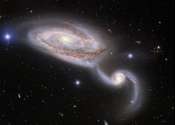New frontier for science as astronomers detect gas molecules in comet from another star
An international team of astronomers, including Queen's University Belfast researchers, have made a historic discovery, detecting gas molecules in a comet which has tumbled into our solar system from another star.









